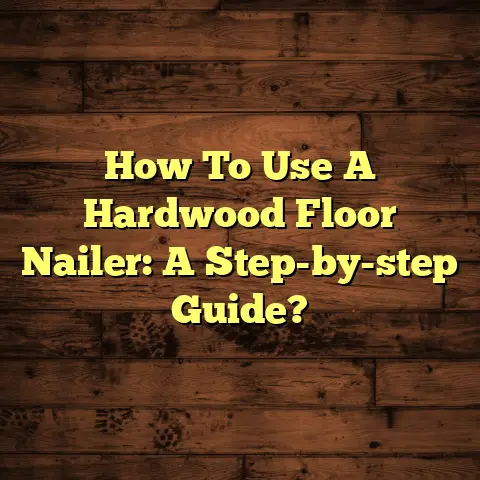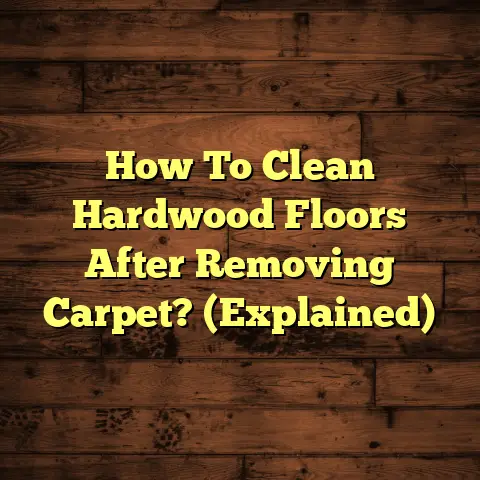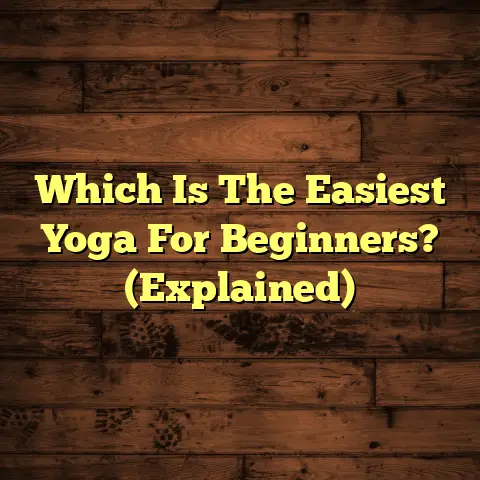Clean LVP Like A Pro! (1 Wrong Cleaner Kills!)
But, and this is a big but, keeping your LVP looking pristine requires the right approach. I’ve seen firsthand the devastation that the wrong cleaner can inflict. We’re talking irreversible damage, folks. Think discoloration, warping, and a dull, lifeless sheen. It’s heartbreaking!
Don’t worry, though! I’m going to share my secrets for fast, effective cleaning solutions that will keep your LVP looking like you just installed it. We’ll cover everything from daily maintenance to tackling stubborn stains. Let’s dive in!
Section 1: Understanding LVP
So, what is Luxury Vinyl Plank, exactly? Well, it’s a multi-layered synthetic flooring product designed to replicate the look of natural materials like hardwood or stone. The key benefits?
- Water Resistance: This is a huge one! LVP is much more resistant to water damage than hardwood, making it perfect for kitchens, bathrooms, and basements.
- Durability: LVP can withstand a lot of foot traffic, scratches, and dents. It’s a great choice for homes with kids and pets.
- Easy Installation: Many LVP products feature click-lock systems, making DIY installation a breeze.
You’ll find LVP used everywhere these days. I install it in residential homes, from cozy apartments to sprawling estates. I also see it in commercial settings like offices, retail stores, and even restaurants.
The composition of LVP is important to understand. It typically consists of several layers:
- Wear Layer: This is the top layer that protects the floor from scratches and wear. Its thickness impacts the durability and longevity of the flooring.
- Print Layer: This layer provides the realistic image of wood, stone, or tile.
- Core Layer: This is the main structural component, often made of PVC or WPC (wood-plastic composite).
- Backing Layer: This bottom layer provides stability and cushioning.
This layered construction means that LVP requires specific cleaning methods. Harsh chemicals can penetrate the wear layer and damage the print layer or core.
Section 2: The Importance of Proper Cleaning
Why is proper cleaning so crucial for LVP? Well, beyond just aesthetics, it directly impacts the lifespan and performance of your floor.
Think of it this way: your LVP is an investment. Proper cleaning protects that investment. Neglecting your LVP can lead to a buildup of dirt and grime, which can dull the finish and make it more susceptible to scratches.
But the real danger lies in using the wrong cleaners. I’ve seen it all:
- Discoloration: Harsh chemicals can bleach or fade the color of your LVP.
- Warping: Some cleaners can damage the core layer, causing the planks to warp or buckle.
- Loss of Sheen: Abrasive cleaners can scratch the wear layer, resulting in a dull, lifeless appearance.
I’ve seen estimates that proper maintenance, including using the right cleaning products, can extend the lifespan of LVP flooring by 5-10 years. Think of the cost savings!
Section 3: Fast Solutions for Daily Cleaning
Okay, let’s get down to the nitty-gritty. What are some quick and easy ways to keep your LVP clean on a daily basis?
Here are my go-to methods:
-
Sweeping or Vacuuming: This is your first line of defense. Use a soft-bristled broom or a vacuum with a hard-floor attachment to remove dirt, dust, and debris. I recommend doing this daily, especially in high-traffic areas.
- Pro Tip: Empty your vacuum’s dustbin or bag frequently to maintain optimal suction.
-
Damp Microfiber Mop: For light cleaning, a damp microfiber mop is your best friend. Microfiber is super absorbent and won’t scratch your LVP.
- How-To: Dampen the mop with warm water. Make sure it’s damp, not soaking wet. Wring out any excess water. Mop the floor in smooth, overlapping strokes. Rinse the mop frequently and replace the water as needed.
-
Ready-to-Use LVP Cleaners: These are a lifesaver when you’re short on time. Look for pH-neutral cleaners specifically designed for LVP.
- My Recommendation: I personally use and recommend Bona Stone, Tile & Laminate Floor Cleaner. It’s pH-neutral, streak-free, and safe for LVP.
- How-To: Simply spray the cleaner onto the floor and wipe with a microfiber mop. No rinsing required!
These daily cleaning methods are quick, easy, and effective. They’ll help prevent dirt and grime from building up and keep your LVP looking its best.
Section 4: Deep Cleaning Techniques
Even with regular daily cleaning, your LVP will eventually need a deeper clean. I recommend deep cleaning your LVP weekly or monthly, depending on the amount of traffic and dirt it’s exposed to.
Deep cleaning removes stubborn stains, restores shine, and helps maintain the overall health of your floor.
Here are a few deep cleaning solutions that are safe for LVP:
-
Vinegar and Water Solution: This is a classic, eco-friendly option. Vinegar is a natural disinfectant and can help remove dirt and grime.
- Recipe: Mix 1/2 cup of white vinegar with 1 gallon of warm water.
- How-To: Dampen a microfiber mop with the vinegar solution. Wring out any excess water. Mop the floor in smooth, overlapping strokes. Rinse the mop frequently and replace the solution as needed. Allow the floor to air dry.
-
Commercial LVP Cleaners: There are many excellent commercial LVP cleaners available. Just be sure to choose one that is pH-neutral and specifically designed for LVP.
- My Recommendation: Armstrong Flooring Once ‘n Done Resilient & Hard Surface Floor Cleaner. It’s designed for vinyl floors and provides a deep clean without damaging the finish.
- How-To: Follow the manufacturer’s instructions on the bottle. Typically, you’ll need to dilute the cleaner with water and apply it to the floor with a mop.
-
DIY Baking Soda Paste: For tough stains, baking soda can be a lifesaver.
- Recipe: Mix baking soda with a little water to form a paste.
- How-To: Apply the paste to the stain and let it sit for a few minutes. Gently scrub with a soft-bristled brush or cloth. Rinse the area with clean water and dry with a microfiber cloth.
Step-by-Step Guide to Deep Cleaning:
- Clear the Area: Remove any furniture, rugs, or other obstacles from the floor.
- Sweep or Vacuum: Remove any loose dirt and debris.
- Prepare Your Cleaning Solution: Choose one of the deep cleaning solutions mentioned above and prepare it according to the instructions.
- Mop the Floor: Dampen a microfiber mop with the cleaning solution. Wring out any excess water. Mop the floor in smooth, overlapping strokes.
- Rinse the Mop Frequently: Rinse the mop frequently and replace the cleaning solution as needed.
- Dry the Floor: Allow the floor to air dry or use a clean, dry microfiber cloth to dry it.
- Replace Furniture: Once the floor is completely dry, replace the furniture and rugs.
Section 5: The One Cleaner to Avoid
Okay, folks, this is the most important part of the article. There’s one cleaner that I absolutely forbid my clients from using on their LVP:
Ammonia-Based Cleaners
Yes, that’s right. Ammonia, a common ingredient in many household cleaners, is a death sentence for LVP.
Why? Well, ammonia is a strong alkaline chemical. It can react with the PVC in the LVP, causing:
- Discoloration: Ammonia can bleach or yellow the surface of your LVP.
- Dulling: It strips away the protective finish, leaving your floor looking dull and lifeless.
- Weakening: Over time, ammonia can weaken the structural integrity of the LVP, making it more susceptible to damage.
I’ve seen countless floors ruined by ammonia-based cleaners. Clients call me in a panic, saying their floor looks cloudy or discolored after cleaning. In many cases, the damage is irreversible.
Anecdotal Evidence:
I had one client who used an ammonia-based cleaner on their brand-new LVP floor. Within weeks, the floor started to yellow and lose its shine. They tried everything to fix it, but nothing worked. Eventually, they had to replace the entire floor. It was a costly mistake!
Alternative Products:
Instead of ammonia-based cleaners, use pH-neutral cleaners specifically designed for LVP. As I mentioned earlier, Bona Stone, Tile & Laminate Floor Cleaner and Armstrong Flooring Once ‘n Done Resilient & Hard Surface Floor Cleaner are excellent options.
Read the Labels!
Always read the labels of your cleaning products carefully. Look for ingredients like ammonia, bleach, or harsh abrasives. If you’re unsure, err on the side of caution and choose a cleaner specifically designed for LVP.
Section 6: Preventative Maintenance Tips
Prevention is always better than cure! Here are some fast tips for preventative maintenance that can save you time and headaches in the long run:
-
Use Mats and Area Rugs: Place mats at entrances to trap dirt and debris before they get tracked onto your LVP floor. Use area rugs in high-traffic areas to protect the floor from wear and tear.
- My Recommendation: Use non-staining mats and rugs.
-
Regular Cleaning Schedule: Set up a regular cleaning schedule and stick to it. This will prevent dirt and grime from building up and make cleaning easier in the long run.
- Example: Sweep or vacuum daily, damp mop weekly, and deep clean monthly.
-
Address Spills Promptly: Clean up spills immediately to prevent them from staining or damaging your LVP. Use a clean, dry cloth to blot the spill. Avoid rubbing, as this can spread the stain.
- Pro Tip: For tough stains, use a baking soda paste or a commercial stain remover specifically designed for LVP.
-
Use Furniture Pads: Place furniture pads under the legs of your furniture to prevent scratches and dents.
- My Recommendation: Felt pads are a great option.
-
Avoid High Heels: High heels can damage LVP floors. Encourage guests to remove their shoes or wear soft-soled shoes.
-
Trim Pet’s Nails: Keep your pet’s nails trimmed to prevent scratches.
-
Be Careful with Heavy Objects: When moving heavy objects, use furniture sliders or dollies to protect the floor.
Conclusion
So, there you have it! My expert guide to cleaning LVP like a pro. Remember, the key is to use the right cleaning solutions and follow a regular cleaning schedule.
By avoiding ammonia-based cleaners and embracing quick, effective cleaning methods, you can keep your LVP looking like new for years to come.
Don’t underestimate the power of preventative maintenance. A little effort goes a long way in protecting your investment and keeping your floors looking beautiful.
Now go forth and conquer those floors! And remember, if you’re ever unsure about a cleaning product or technique, don’t hesitate to consult a professional. Your LVP will thank you for it!





